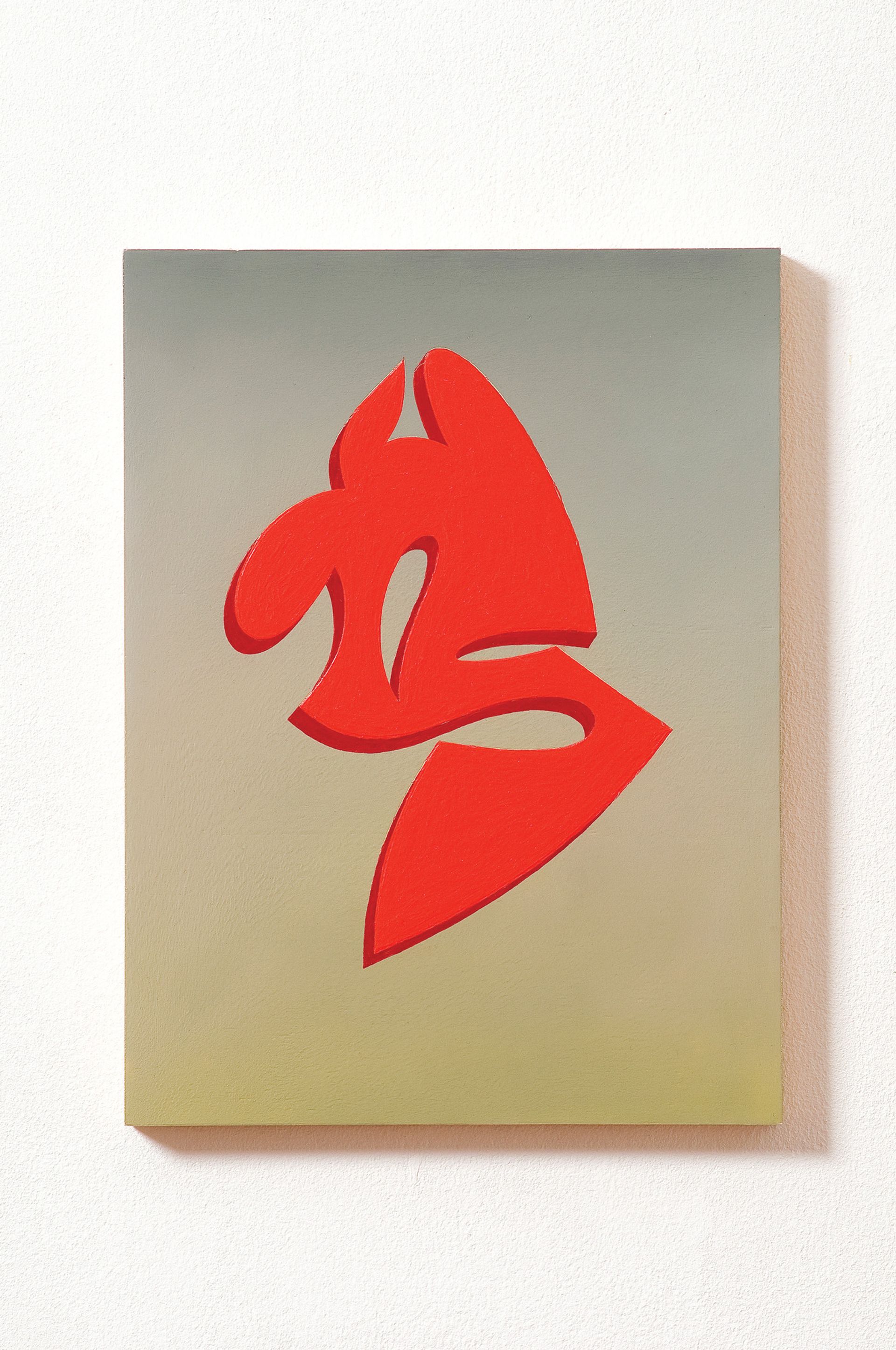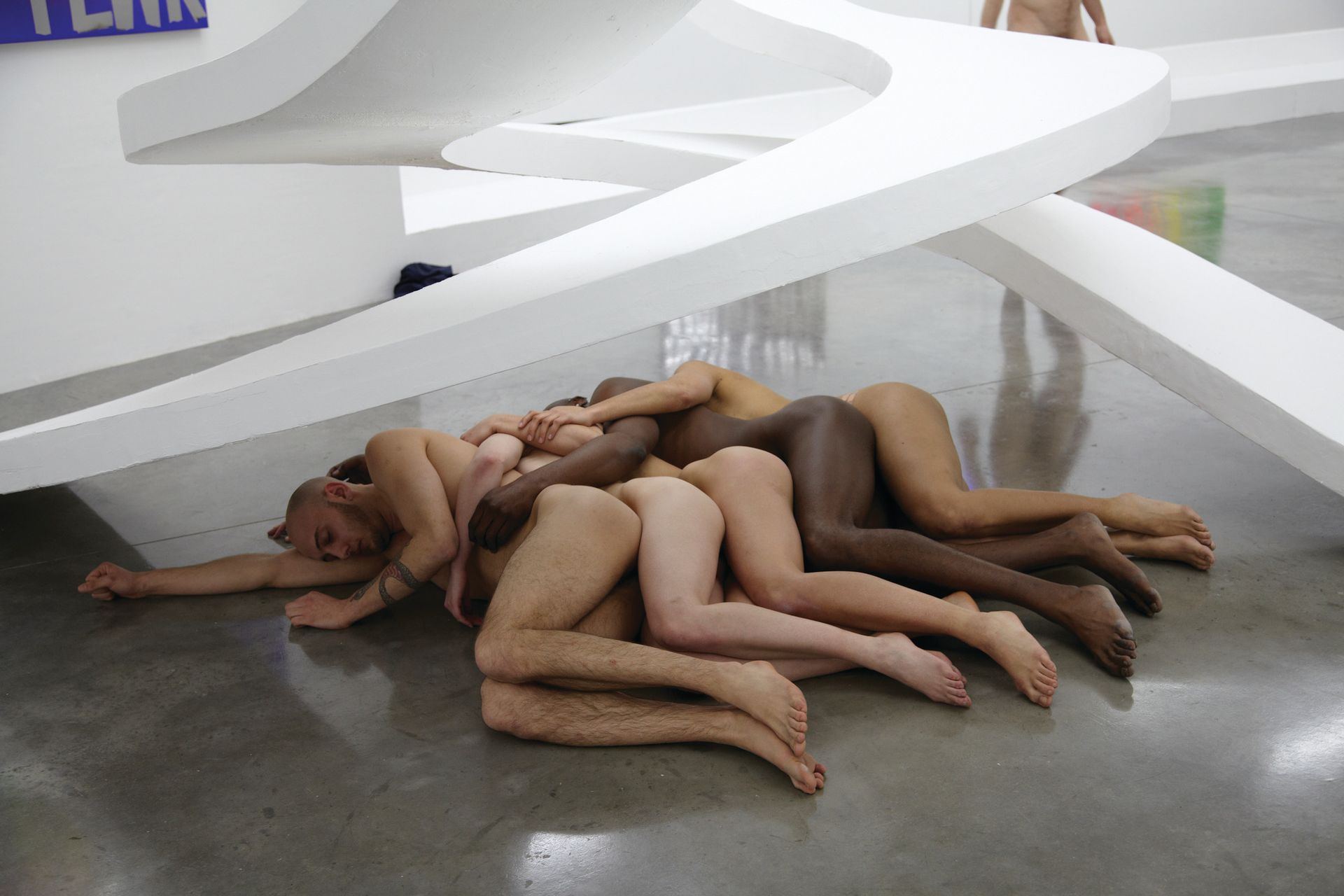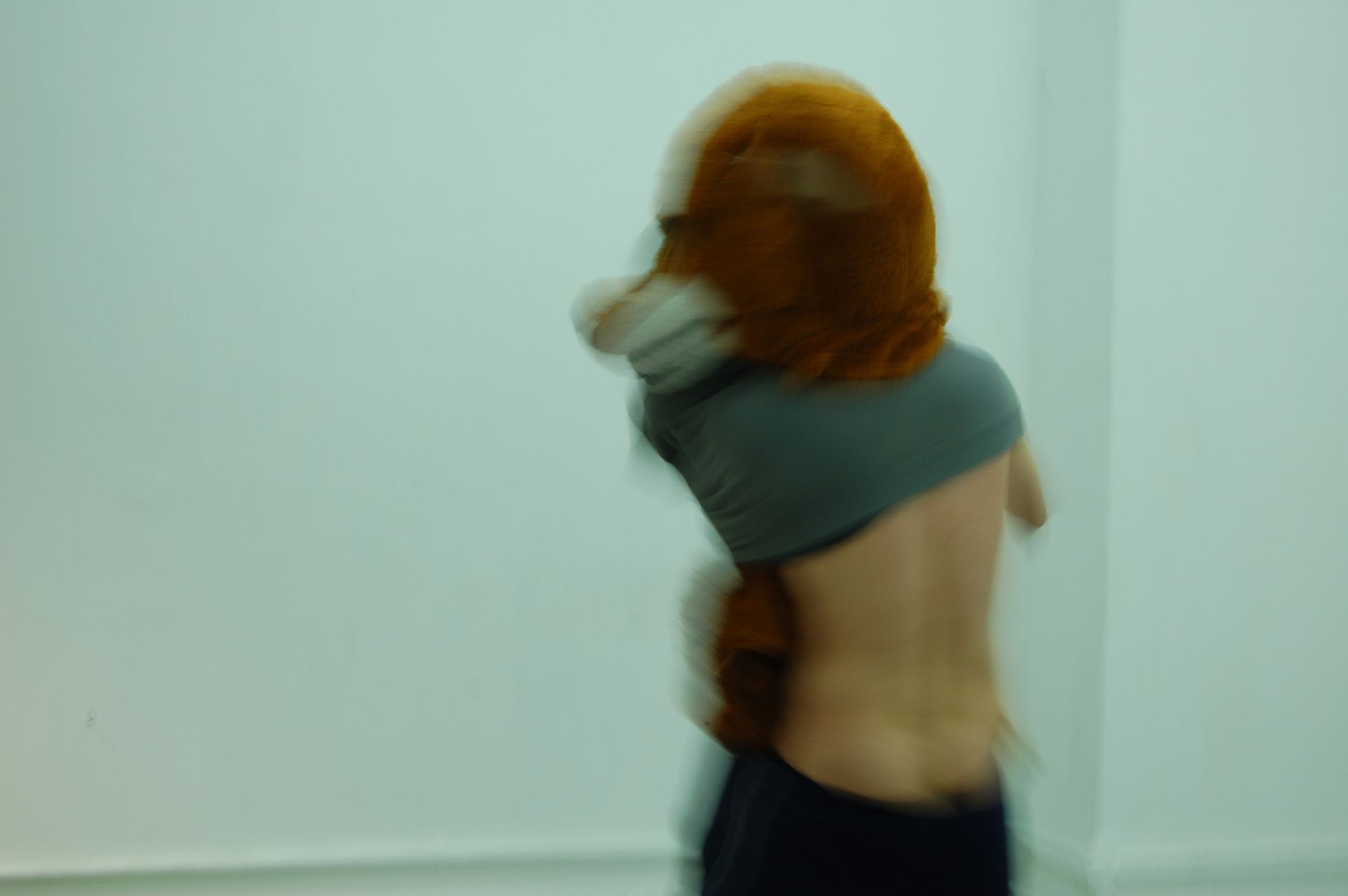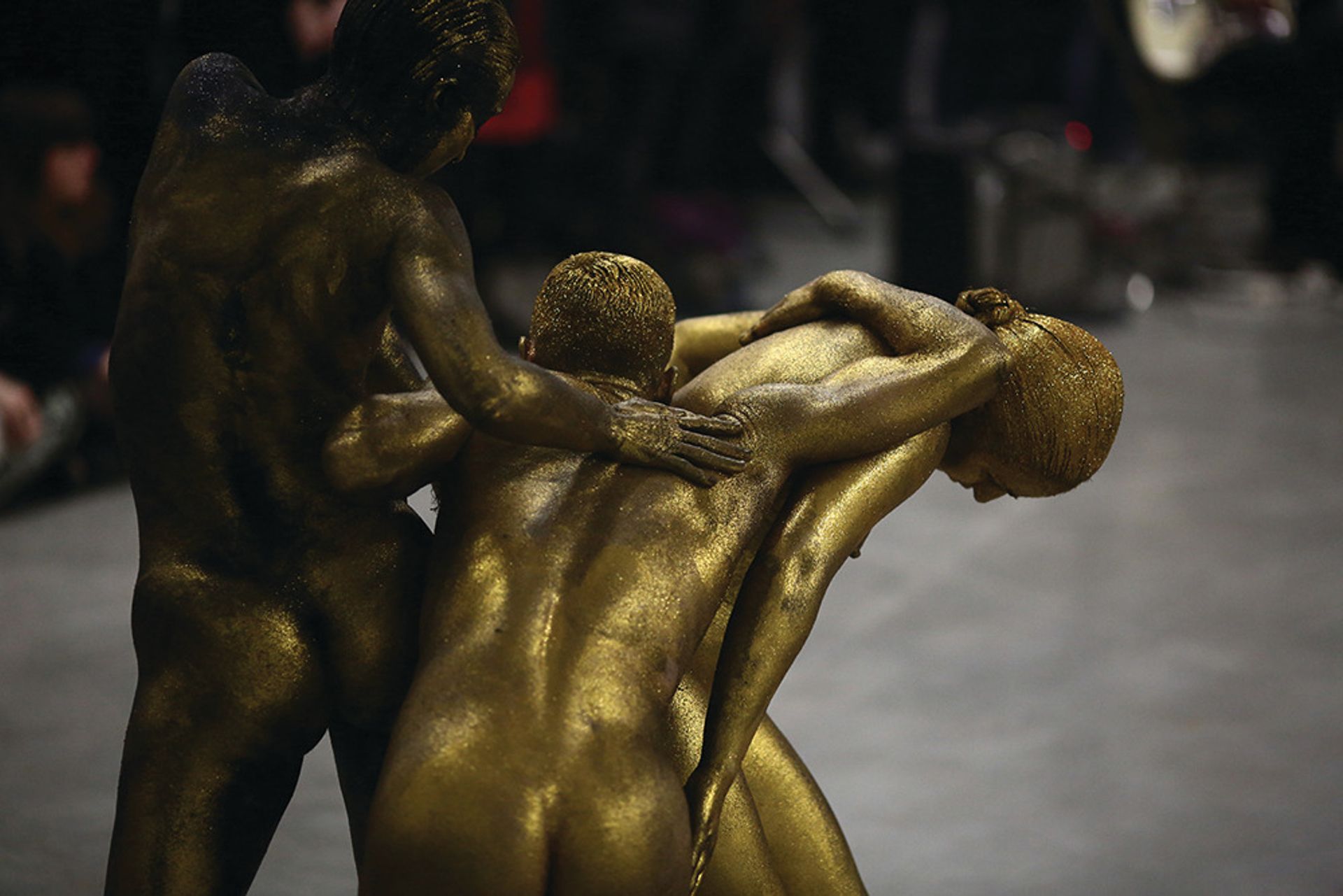Over the past few years, Eddie Peake has been propelled to art-world prominence by his ambitious, often sexually provocative use of live performance, dance and specially composed music, which he frequently combines with paintings, sculpture and architectural installations. Peake first attracted widespread attention by staging a naked five-a-side football match—the teams were distinguished by their socks—at the Royal Academy of Arts in 2012, while still studying at the RA Schools. Before graduating, he created dance performances for the Chisenhale Gallery, Tate Modern’s Tanks and Performa 13 in New York, as well as having his first major show at White Cube; he is the first young British artist to be taken up by the gallery for some time. Now, the 34-year-old artist, who also runs a cult club night called Anal House Meltdown with fellow artists George Henry Longly and Prem Sahib, is producing a multimedia gesamtkunstwerk for the Curve, a 90m-long gallery at the Barbican, London—his largest show yet.
The Art Newspaper: The Curve is a very particular shape—how are you working with it?
Eddie Peake: The main idiosyncrasy, apart from its magnitude, is that although it’s one unbroken space, you can’t see it all at any one time, so it has an inherent narrative quality. A sense of narrative and wandering, and a manipulation, in the best possible sense of that word, of the viewer’s journey through a gallery—their gaze and their expectations—are all things that I like to make emphatic use of in my work, so I feel very much at home in that space. I feel it is generous and lends itself very naturally to my processes and my work.
You have emphasised the Curve’s processional qualities by building a raised, scaffolded walkway and surrounding it with a maze of other structures.
Although it was more of a by-product than an original intention, there is a self-reflexive echoing and commentary on the Barbican’s architecture. I really love its labyrinthine quality. So there’s a large, maze-like, plastered-wall structure with windows and smashed holes, which directs the viewer’s gaze on to other works in the show—and on to the other viewers too—and directly implicates the viewer as a part of the show.
Then there’s the constant presence of live performers, who are synchronised with sound and videos.
Yes, the film and performance are totally constant: all day and every day of the show. The film is half-an-hour long, and is a newly made montage of my own new and old footage, constantly looped throughout the duration of the exhibition. The performance is also half-an-hour long, and is looped constantly throughout the show. They are both timed so that the live performance and the video are a kind of pas de deux. Sometimes they synchronise, then at other times they may be doing different things, and then at other times they might even have a dialogue.
“Imagine what the conversation would be if we didn’t have those words gay, straight, bi, trans—or even woman or man”
Do you consider the viewer to be an active protagonist?
To my mind, the viewer’s journey through and experience of an exhibition is a work in itself. I’m even thinking of giving it a title in this show. But I want to make clear that I really don’t like audience participation, and so I’m talking about something different. I don’t really consider the viewer to be an active protagonist, but rather that, simply by virtue of the fact that you walk into a gallery, you are part of the work. And I like the fact that the viewer in an art gallery isn’t afforded the opportunity to be anonymous or passive, as is the case in, say, a cinema or theatre. In a gallery, you are on display as much as the work is, especially in a performance situation, and I like playing with that. But I want this to be done in a way that the audience is party to. I can’t stand it as a viewer when I feel that I am part of a joke that I’m not aware of.
You’ve said that you “create situations that push what people consider to be OK”.
One thing I am always drawn to in art is when something feels incongruous. If something feels as though it’s the wrong thing to be happening in a given space or context, then that feels as though it is the right thing for me to make as a work.
You often appear in your work: is there a particular reason?
It’s about using what’s immediately available, and I think it lends credibility to my desire to work with other people in a certain capacity. I also enjoy it: I have an extrovert, show-off impulse and I just want to be involved. But since 2010, when I did a piece specifically for the internet [Ciao, made in collaboration with Paul Simon Richards], I’ve wanted to step outside the work a bit and to see it more objectively and impartially.
At www.eddiepeake.com, there’s just a photograph of your penis. Why?
It’s been there since 2006, when I left the Slade. I wanted to have a website but I definitely did not want to have a website that was an archive of my work. Instead, I wanted it to function as a work. So it’s a piece of work, and it’s called eddiepeake.com. I also like the fact that I have had this website for nearly ten years and there’s only been one image. I see that as some form of reaction to, or commentary on, the plethora of imagery that we are bombarded with every single day, and specifically online. I’m not being a grumpy old Luddite; I love looking at imagery, but I do feel as though a certain kind of dilutedness has happened to the power of imagery as a result of the tirade that we encounter online every day. I like the commitment it requires to say: “No, my website is going to be just one image—and I’m going to stand by this image because I think it’s a powerful, beautiful image.”
Your use of nudity and sexual imagery seems to confound and confuse conventional sexual stereotypes.
A constant theme in my work is to do with sexuality and desire, but often not the usual imagery you’d expect to see filtered through a male gaze.
Certainly not a heterosexual one…
I don’t call myself heterosexual. I’d rather just say I have a girlfriend. I remember reading Judith Butler’s [1990 book] Gender Trouble, where she paraphrases Simone de Beauvoir as saying that there are as many sexualities in the world as there are people. I subscribe to that view completely. Imagine what the conversation would be if we didn’t have those words gay, straight, bi, trans—or even woman or man. I think those terms have been quite unhelpful and actually quite dangerous, sometimes. The thing I’m compelled by is imagery and ideas; it’s become apparent to me that what I’m interested in is the transcendence of categorised normative sexuality and, by implication, other things: normative roles in society, race, art.
You have made oblique references to artists including Michelangelo and Poussin.
For me, the history of art is more like an ongoing wrestling match than a total embrace. I don’t like tradition—I find it frustrating and limiting. It’s the biggest cliché ever, but I just want to feel free and to be able to move in any direction. Tradition and history and academia are things that bind us culturally to a particular way of thinking that makes one thing acceptable, but not another.
• Eddie Peake: the Forever Loop, Barbican Art Gallery, 9 October-10 January, www.barbican.org.uk
Key Works

Something Sinister (2009)
“In 2008, I moved to Rome. Until then, I had pointedly endeavoured to make work in a multitude of different methods and media, sometimes on my own and sometimes in collaboration. I still work in this way, but when I moved to Rome, I saw it as an opportunity to return to my first true love—painting—which I abandoned soon into my time at the Slade. I was able to see painting from a new perspective, and with a more rounded and less hermetic view in relation to art and the world at large. I wanted painting to be a hook on which everything else I do could hang, and so I began a series of small oil paintings, each one 40cm by 30cm, which I am still making today. This painting is from the first group, and it has become a kind of template for some works I am making now, my Mask Paintings and Smiley Paintings, in which a face-like flat form stares at the viewer.”

Adjective Machine Gun (2013)
“This was an exhibition that encompassed a variety of media, including an ongoing performance at White Cube in 2013. It was an absolute marathon and a real slog but one I’m glad to have done. I felt really proud of that show. It was the first time I’d shown everything—performance, paintings and objects—all together, with the making and devising of the performance in situ comprising the performance itself. It was really, really pronounced and ballsy, I think… in a confident way. The central structure was based on Berthold Lubetkin’s Penguin Pool [at London Zoo]. As well as the dancers and musicians, a roller-skater in a sheer nude suit was a consistent presence throughout, and, in my mind, the adjoining factor between the various different things going on in the show, constantly moving between them.”

Fox (2005)
“This was a performance made in collaboration with Sam Hacking when we were both in our final year at the Slade. I would characterise much of my work up until then as being performative, though not necessarily performance. But this was my first actual performance, with solely live elements, a beginning, middle and end, and an audience of our tutors and fellow students. It was a fairly simple work in that it involved two performers—us, incidentally—switching clothes, though one of us was wearing a fancy-dress fox costume, with the one governing rule being that the two performers should not expose any part of their bodies: obviously an impossibility, but an impossibility that inevitably facilitated a drama. I see it now as a sort of template for much of my work since, with its intense physicality, the two characters in a sometimes loving, sometimes sexual, sometimes silly, sometimes rape-like tangle, and an implicit theme of the struggle of relationships.”

Endymion (2013)
“Sometimes it just feels as though everything comes together and slots into place like a jigsaw puzzle, and I had that experience with this work. It was the culmination of a number of performances that I’d made in recent years, specifically at the Tate and at the Chisenhale Gallery. It was the apex of that lineage of work: a large ensemble of actors, dancers and musicians and a narrative structure devised out of rehearsals. It was an hour long. Four of the dancers were painted from head to toe in gold and three in black; the three musicians wore black clothes but had painted faces. It was my first solo commission in New York, and I can’t convey the extent to which I felt horrifying, anxiety-inducing levels of pressure. The great and the good of the New York art world came and I felt as though it was all set up for me to fail, but the stars aligned and everything worked, most importantly in terms of my feelings about the piece.”
Digest: Eddie Peake
Born: London, 1981, to the artist Phyllida Barlow and the artist-writer Fabian Peake. He “didn’t naturally take” to art, preferring to DJ and play in bands until a Damascene moment when making a painting for his A-level.
Education: Graduated with a BA from the Slade School of Fine Art in 2006 and undertook a residency at the British School at Rome between 2008 and 2009 before returning to London, where he completed a postgraduate degree at the Royal Academy Schools in 2013.
Milestones: While still a student, Peake staged Touch (2012), a notorious naked five-a-side football match, as well as two closely related 2013 dance performances, both entitled Amidst a Sea of Flailing High Heels and Cooking Utensils, at the Tate Tanks and the Chisenhale Gallery. Both featured live music and naked, body-painted dancers. In the same year, he was taken up by White Cube, presenting Adjective Machine Gun, an exhibition and ongoing performance, and was commissioned by Performa 13 to produce the dance and live music work Endymion.
Lives: London
Represented by: White Cube, London; Galleria Lorcan O’Neill, Rome

